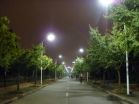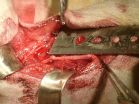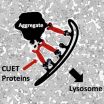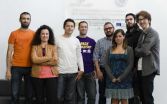(Press-News.org) New Haven, Conn. -- From the physics labs at Yale University to the bottom of a played-out gold mine in South Dakota, a new generation of dark matter experiments is ready to commence.
The U.S. Department of Energy's Office of Science and the National Science Foundation recently gave the go-ahead to LUX-Zeplin (LZ), a key experiment in the hunt for dark matter, the invisible substance that may make up much of the universe. Daniel McKinsey, a professor of physics, leads a contingent of Yale scientists working on the project.
"We emerged from a very intense competition," said McKinsey, whose ongoing LUX (Large Underground Xenon) experiment looks for dark matter with a liquid xenon detector placed 4,850 feet below the Earth's surface. The device resides at the Sanford Underground Research Facility, in South Dakota's Black Hills.
The new, LZ device will boost the size and effectiveness of the original LUX technology.
"We have the most sensitive detector in the world, with LUX," McKinsey said. "LZ will be hundreds of times more sensitive. It's gratifying to see that our approach is being validated."
LZ is an international effort, involving scientists from 29 institutions in the United States, Portugal, Russia, and the United Kingdom. The DOE's Lawrence Berkeley National Lab manages the experiment.
Dark matter is a scientific placeholder, of sorts. Although it can't be seen or felt, its existence is thought to explain a number of important behaviors of the universe, including the structural integrity of galaxies.
LZ's approach posits that dark matter may be composed of Weakly Interacting Massive Particles – known as WIMPs – which pass through ordinary matter virtually undetected. The experiment aims to spot these particles as they move through a container of dense, liquid xenon. That container will be surrounded by a tank of water, along with an array of sophisticated light sensors and other systems.
Putting the device down a mineshaft weeds out cosmic rays, McKinsey said. Gamma rays and neutrinos, however, still will be able to seep into the device. They'll be like tiny bowling balls, careening into the liquid xenon and colliding with electrons. Those collisions will be identified and factored out.
The researchers hope that the remaining collisions, the ones involving nuclei, will identify the presence of dark matter. "It comes down to distinguishing between electron and nuclear recoils," McKinsey said.
LZ will be a meter taller and significantly wider than its predecessor. The amount of xenon will jump from 250 kilograms to 7,000 kilograms. Such considerations become critical when you're conducting research in a mine, according to McKinsey.
"Everything has to come down in the same cage," he said.
As with LUX, a number of systems and components for LZ will be designed and built at Yale. For example, McKinsey said, team members in New Haven will work on calibration systems. They also will construct a system for bringing high voltage into the device's lower grid.
The goal is to have LZ operational in 2017, while continuing work with the LUX experiment.
"We want to get moving soon," McKinsey said. "We have new systems we want to start testing. Our activity has begun."
Two other dark matter initiatives also earned support. Those are the SuperCDMS-SNOLAB, which will look for WIMPs, and ADMX-Gen2, which will search for axion particles.
INFORMATION: END
It's go time for LUX-Zeplin dark matter experiment
2014-07-18
ELSE PRESS RELEASES FROM THIS DATE:
Improving driver safety: How to prevent streetlight glare in the new world of LED lighting
2014-07-18
WASHINGTON, July 18—Long hours of nighttime driving can cause eyestrain because while our vision adapts to the surrounding darkness, the sudden stabs of brightness from streetlamps can be irritating, distracting and even painful. Even as LED technology has transformed the lighting industry, bringing the promise of more energy-efficient road illumination, some fear that the new lights could cause even more troublesome, unsafe glare.
A team of researchers from China and the Netherlands has developed a way to evaluate the human impact of uncomfortable glare caused by LED ...
NASA sees super typhoon Rammasun eyeing landfall
2014-07-18
Imagery from NASA's Aqua satellite captured a wide-eyed Typhoon Rammasun as it was making landfall in northern Hainan Island, China early on July 18. A rainfall analysis using another NASA satellite showed the flooding potential of the storm as it left the Philippines and headed for China. Now, Rammasun is headed for a final landfall near the northeastern border of Vietnam and China.
On July 17, an analysis of Typhoon Rammasun's rainfall was conducted at NASA's Goddard Space Flight Center in Greenbelt, Maryland. The rainfall analysis covered the storm's rainfall from ...
NASA satellite catches birth of Tropical Storm Wali near Hawaii
2014-07-18
The first tropical cyclone of the season has formed in the Central Pacific Ocean as NASA's Terra satellite passed overhead. Tropical Storm Wali formed southeast of the Big Island of Hawaii, and now that it's nearing, a Flash Flood Watch has been posted for all of the islands.
NASA's Terra satellite passed over Wali on July 17 at 19:55 UTC (3:55 p.m. EDT) just as it was being classified as Tropical Depression 1C. NOAA's Central Pacific Hurricane Center (CPHC) issued an advisory at 5 p.m. EDT (11 a.m. HST) announcing the birth of the depression near 12.7 north and 140.7 ...
A rhesus monkey model of radial nerve injury for evaluating peripheral nerve repair
2014-07-18
Current research on bone marrow stem cell transplantation and autologous or xenogenic nerve transplantation for peripheral nerve regeneration has mainly focused on the repair of peripheral nerve defects in rodents. Dr. Dong Wang and his team, First Affiliated Hospital of Sun Yat-sen University, China established a standardized experimental model of 2.5 cm-long radial nerve defects in rhesus monkeys and evaluated the effect of repair on peripheral nerve injury. The quality of nerve regeneration in the bone marrow stem cells-laden allografts was comparable to that achieved ...
Intranasal nerve growth factor repairs injured spinal cord neurons
2014-07-18
Nerve growth factor can be delivered to the brain by intranasal administration without risk for treatment of brain diseases. Dr. Luigi Aloe, Cellular Biology and Neurobiology Institute, National Research Council, Italy and his team performed a study to investigate whether, by intranasal administration, the nerve growth factor bypasses the blood-brain barrier and turns over the spinal cord neurons. Results showed that at 3 weeks after intranasal administration of nerve growth factor, the contents of nerve growth factor and its receptor in the spinal cord were increased, ...
How does L-carnitine maintain the normal structure of sciatic nerve in crush injury?
2014-07-18
Several studies have demonstrated that L-carnitine exhibits neuroprotective effects on injured sciatic nerve of rats with diabetes mellitus. Dr. Ümmü Zeynep Avsar, Faculty of Medicine, Ataturk University, Turkey and his team proposed a hypothesis that L-carnitine exhibits neuroprotective effects on injured sciatic nerve of rats. Rat sciatic nerve was crush injured by a forceps and exhibited degenerative changes. After intragastric administration of 50 and 100 mg/kg L-carnitine for 30 days, axon area, myelin sheath area, axon diameter, myelin sheath diameter, and numerical ...
Novel mechanism for invasion of EV71 virus demonstrated
2014-07-18
A new study determines glycosylation and pH-dependent conformational changes of virus receptor SCARB2 as crucial for EV71 attachment, entry and uncoating
Enterovirus 71 (EV71) is the major causative agent of hand, foot and mouth disease (HFMD) in the Asia-Pacific region, having caused 8.8 million infections and 3,000 deaths in China in the past five years. Unlike other enteroviruses (e.g. Coxsackievirus), EV71 can cause severe aseptic meningitis, encephalitis, myocarditis and acute flaccid paralysis, thus leading to significant fatality rates. Unfortunately, the molecular ...
A new cellular garbage control pathway with relevance for human neurodegenerative diseases
2014-07-18
This news release is available in German.
Proteins, the components of our body that execute, control and organize basically all functions in our cells, are made out of strings of amino acids, which – like an origami - are folded into specific and complex three-dimensional structures according to their desired functions. However, since folding and maintaining of such structures is highly sensitive to cellular or environmental stress, proteins can potentially misfold or form clumps (aggregates). Such undesired protein waste can be toxic for cells and may even lead ...
New inexpensive and easy computer software provides real-time and highly accurate data on traffic
2014-07-18
Researchers at the University of Granada have designed new software that provides real time data on traffic. It is a device that provides information on traffic flow between cities. Drivers can use this information to choose the fastest route as they plan to drive to their destinations.
It is a highly reliable, low-cost method, easy and quick to install, which uses bluetooth devices. These devices collect real-time data on road traffic which it then sends to a central server. This information is then processed using complex data mining algorithms, evolutionary computing ...
Consuming probiotics for a month helps diminish fat accumulation in the liver, new study says
2014-07-18
Spanish scientists have demonstrated through an experiment on obese rats that the consumption of probiotics during thirty days helps diminish the accumulation of fat in the liver. This new finding, published today by the journal PLOS ONE, is a great step forward on the fight agains the Non-Alcolohic Fatty Liver Disease (NAFLD), which is closely related to obesity and diabetes.
Researchers from the 'Nutrition Biochemistry: Theurapetic Applications' group (CTS-461) and the José Mataix Institute for Nutrition and Food Technology at the University of Granada have demonstrated ...





